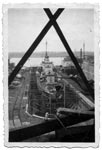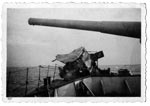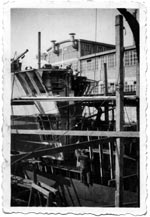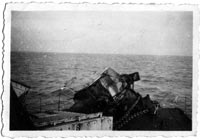My 7th
draft H.M.S. BRILLIANT
I remained
in Chatham Depot after I was discharged from the hospital until I
was drafted to the Destroyer H.M.S. BRILLIANT I served aboard from
the 13/11/1944 until the 15/6/45 her Pennant (H84) She was a "B" Class Destroyer (Built by Swan & Hunter. Launched in 1930, sold in 1947 and broken up at Troon)
Its duties were to escort shipping along the south coast, another
duty, when it was out turn, was to be the stand-by Destroyer.
This meant to be on a 4 hour stand-by in Portsmouth harbour and
having "Steam Up" ready for sea. It was rumoured that
this duty was to carry VIP's to safety, should the situation
arise.
On December 24th,1944 the troopships S.S.Leopoldville, and the
S.S.Cheshire left Southampton to cross the Channel. H.M.S.
Brilliant, H.M.S Anthony H40, H.M.S.Hotham and the Free and the
French frigate Croix de Lorraine were the escorts. Captain J. Pringle of HMS Brilliant,
then signaled the Leopoldville and the other vessels to
commenence zagging, a command that had never before been given to
the Leopoldville during a Channel crossing, but which seemed
advisable due to recent increased submarine activity. At
14-30hrs, Brilliant hoisted the Black Flag to warn the escorts
that a submarine contact had been made. We moved out to drop
depth charges. At 14-45hrs the alert was canceled, but another
alert was called at 15-00hrs, again being canceled at 15-10hrs.
The convoy resumed its diamond-shaped formation, with Brilliant,
Leopoldville, Cheshire, and Croix de Lorraine in a line, the
Anthony and Hotham taking wing positions, and recommenced
zigzagging at 13 knots.
The Leopoldville was transporting approximately 2235 American
soldiers of the 66th.Infantry Division across the channel
to re-enforce the troops at the
Battle of the Bulge. At 17-45hrs, a torpedo, fired by the U486,
struck the Leopoldville, on the starboard side aft and exploded
in Number 4 Hold, approximately 5 miles off CHERBOURG.
Compartments E-4, F-4 and G-4 were flooded and stairways were
blown away, but a few of the three hundred men in those
compartments managed to escape to higher decks.
H.M.S. Brilliant went along the port side of the troopship we had
put our starboard fenders over the side; the sea swell was
causing a rise and fall of between 8ft and 12ft. The scrambling
nets were hanging down the Leopoldvilles's port side and the
American soldiers were coming down on to our upper deck. Some men had
started to jump down from a height of approximately
40ft. Unfortunately limbs were being broken when they landed on
the torpedo tubes and other fixed equipment on the starboard side
of the upperdeck; some men fell between the two vessels and were
crushed as the two vessels crashed into each other. To avoid any
further injuries, if possible, all our hammocks were brought up from
our mess-decks below and laid on the starboard upper deck to cushion
the fall of the soldiers as they landed.
The servicemen were asked to spread themselves as evenly as
possible all over the ship, above and below decks to avoid the
possibility of capsizing. At 19-20hrs, having taken on about 500
men, we pulled away from the Leopoldville as there was only
a few inches of free board. I was very much aware of this, as I
was standing right on the stern port quarter. To use an old naval
expression, we could easily have been "pooped" As we
headed for the port of Cherbourg we passed the some of the rescue
craft heading for the Leopoldville. The other escorts in the
convoy were still hunting for the U-boat 486. The scene on
entering Cherbourg harbour was one of chaos, most of the ships
along the quay had suffered the fate of being scuttled by the
Germans. There was one berth available on our port side as we
entered the harbour. There was just enough space, lengthways, to
get along side but the captain was unable to berth the ship just
by using his two propellers. After about 15 minutes, an American
soldier came to the rescue with his jeep. A line was thrown to
him from our stern section, he placed it over his Jeep's tow hook
and slowly pulled the stern along side of the quay then placed
the line over a bollard. He repeated the same action at the bow.
The gangway was put out for the American servicemen to start
dis-embarking. I saw them putting their English money into a GI's
tin hat as they left the ship, which was handed to one of our
officers. No doubt it was showing their appreciation at their rescue.
It is on record that HMS BRILLIANT rescued approximately 500 men at
that firstattempt but on our return to rescue more men, the LEOPOLDVILLE
had sunk. The losses so I have read were 802 soldiers, 516 were
missing 248 died from their injuries This catastrophe was kept under
wraps and not disclosed for many years. It was a great embarrassment
to the British & American Governments (See Web site- U-boat Net-
History- SS Leopoldville). I do highly recommend this web site to
all those persons interested in the history of WW2 The Battle of
the Atlantic.
A DOCUMENTARY FILM IS TO BE SHOWN ON THE 16TH OF AUGUST 2009 ON THE HISTORY CHANNEL & HISTORY HD AT 9PM. INCLUDED WILL BE THE RE-ENACTMENT OF H.M.S.BRILLIANT GOING TO THE RESCUE OF THE U.S. SOLDIERS ON THE SS LEOPOLDVILLE.
Two days after sinking the LEOPOLDVILLE the U486 torpedoed a
further two British Frigates, the AFFLECK and the CAPEL in the
same area. (I am unable to find any reference to these two
Frigates in the ROYAL NAVY WW2 Web Site, except that some of the
crew of the AFFLECK were picked up by American M.T.B's and taken
to a Cherbourg Hospital.
The British Submarine TAPIR sank U486 on the 12/4/45 North West
of BERGEN and All the crew was lost. We resumed our sea duties in
the channel On the morning of the 21/1/1945 at approximately six o'clock I
was woken by a tremendous crashing sound. I was out of my hammock
and up on deck as quick as lightning, I thought I was the first to
arrive there but two of my mess mates had beaten me to it. We had
collided with the Canadian corvette H.M.C.S.LINDSEY, south west of the Isle
Wight. The collision had split our bow open just about sea level and we were
taking in water.The port anchor and its housing were ripped upwards and came
to rest on the forecastle. 
 (See photographs)
We made our way to DOVER harbour where we spent the remainder of
the day and night. The following morning liquid concrete was
poured into the bows to seal the gaping hole near the water line.
When it was deemed save, we set off across the channel, going astern
all the way to HOBOKEN on the river WESTER SCHELDE in Belgium.
While the repairs were being carried out in the dry dock I
obtained photographs of the damaged bows.
(See photographs)
We made our way to DOVER harbour where we spent the remainder of
the day and night. The following morning liquid concrete was
poured into the bows to seal the gaping hole near the water line.
When it was deemed save, we set off across the channel, going astern
all the way to HOBOKEN on the river WESTER SCHELDE in Belgium.
While the repairs were being carried out in the dry dock I
obtained photographs of the damaged bows.


Half the ships Company was given leave and they went off to the
UK via a returning empty TLC (Tank Landing Craft). A break of
three days had been arranged for small parties of six ratings
from the remaining ship's crew to have a few days in BRUSSELS. On
arrival by train we were taken to the hotel de Colonies which was
the Headquarters of the American forces. I was shown to a large
bedroom with a large bed with an en-suite bathroom/shower room
all to myself. It was a very pleasant experience to sleep in a
comfortable bed for a change. I often wonder at the manner in
which we treated by the Americans in Brussels was the fact that
they were aware of our involment with the Leopoldville. I was due
to go on leave on my return to the Brilliant. My eventual
departure was delayed by one day as the returning crew was
torpedoed in the channel returning from their leave, aboard a
Tank Landing Craft,fortunately no one was hurt or lost.
I, with the other half of the Ships Company went on leave for two
weeks. June 1945.
It was while I was on this leave that Germany surrendered on the
7/5/1945 I returned to the Brilliant after my leave but for the
last time was drafted to Chatham Depot.I spent my remaining time
in the R.N.in Chatham Depot until the news of the Americans'
action of the dropping the two Atom bombs, which ended the war in
the Far East. The demobilisation lists were placed on the notice
boards, I was in group 45. Finally the day arrived and I took my
place in the line I came before the officer and handed him my
pay-book. He looked up at me and said:- I have the authority to
offer you the rank of second lieutenant if I was prepared to sign
on for a further three years OR go on leave and let them know
before the end of the official date of my leave. I was told that
I would receive my discharge papers, by post, within the next few
days and that I should report to a Captain Bull's office, which
was situated in the city centre of HULL, E. Yorks. After
approximately three weeks, I decided to go and see Captain Bull
and inform him that I wished to accep the rank of Sub Lieutenant
but I had not received my discharge papers. He contacted the
Admiralty Dept. and was told to inform me that they had been
posted to my home address, that of my mother and fathers' address
and not having these documents, the offer was withdrawn. It was
many months later that my discharge papers came to light.
Apparently, they had arrived safe and sound a few days after I
arrived home after being discharged from the Navy.

 (See photographs)
We made our way to DOVER harbour where we spent the remainder of
the day and night. The following morning liquid concrete was
poured into the bows to seal the gaping hole near the water line.
When it was deemed save, we set off across the channel, going astern
all the way to HOBOKEN on the river WESTER SCHELDE in Belgium.
While the repairs were being carried out in the dry dock I
obtained photographs of the damaged bows.
(See photographs)
We made our way to DOVER harbour where we spent the remainder of
the day and night. The following morning liquid concrete was
poured into the bows to seal the gaping hole near the water line.
When it was deemed save, we set off across the channel, going astern
all the way to HOBOKEN on the river WESTER SCHELDE in Belgium.
While the repairs were being carried out in the dry dock I
obtained photographs of the damaged bows.
